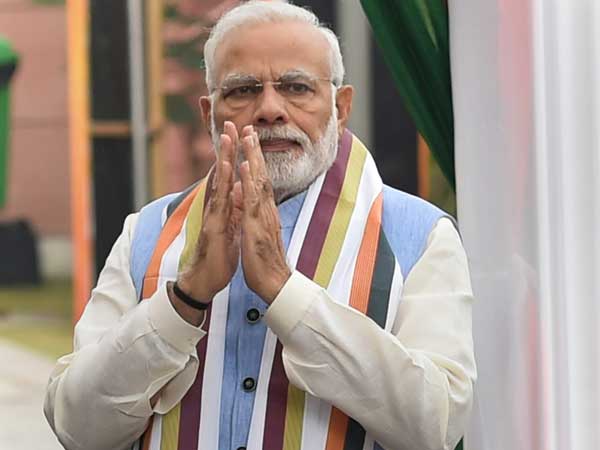
From RSS worker to PM, how Modi rose to become India’s most powerful man
New Delhi, Sep 16: Prime Minister Narendra Modi is set to celebrate his 68th birthday in his parliamentary constituency of Uttar Pradesh's Varanasi district, where he will spend the day with schoolchildren and watch a film based on his life.
Modi is best known for rising from humble beginnings to become prime minister of India. He is known for leading his party Bharatiya Janta Party (BJP) to a historic win in 2014 elections. He rose from a poverty-stricken tea-selling boy to a development-oriented leader, eventually becoming the longest-serving chief minister of Gujarat for 12 years.

Early Life & Family:
Narendra Damodardas Modi was born on September 17, 1950 in the small town of Vadnagar, Mehsana, Gujarat, as the third of six children, to Damodardas Mulchand and Heeraben Modi. Since his childhood days, he was confronted with many difficulties and obstacles, but he transformed all the challenges into opportunities by sheer strength of character and courage.
After completing his schooling in Vadnagar in 1967, he left home and traveled across India exploring its expansive landscape and diverse culture, visiting Rishikesh, the Himalayas, Ramakrishna Mission and Northeast India.
In 1971, Modi returned home after two years and went to Ahmedabad to join Rashtriya Swayamsevak Sangh (RSS) as a fulltime pracharak (campaigner).
He completed his graduation from Delhi University in political science through correspondence in 1978, and obtained a Masters degree in political science from Gujarat University in 1983.
Political Career:
During the 1975-77 political crisis, Prime Minister Indira Gandhi declared a state of emergency, banning political organizations such as the RSS. Modi went underground and wrote a book, Sangharsh ma Gujarat (Gujarat in Emergency), which chronicles his experiences as a political fugitive. He joined the BJP in 1985 and was made the organization secretary of its Gujarat Unit in 1987. He contested for Ahmedabad Municipal Corporation elections and won the same, giving BJP its first ever win.
In 1987, Narendra Modi joined the Bharatiya Janata Party (BJP), which stood for Hindu nationalism. His rise through the ranks was rapid, as he wisely chose mentors to further his career. He promoted privatization of businesses, small government and Hindu values. In 1995, Modi was elected BJP national secretary, a position from which he successfully helped settle internal leadership disputes, paving the way for BJP election victories in 1998.
Modi was reelected chief minister of Gujarat in 2007 and 2012. Through those campaigns, Modi's hard-line Hinduism softened and he spoke more about economic growth, focusing on privatization and encouraging policies to shape India as a global manufacturing epicenter. His government was accused of not doing enough to curb the Gujarat riots of 2002. The riots occurred in retaliation to burning of Hindu pilgrims in a train near Godhra.
He was forced to step down as the Chief Minister following opposition from both inside and outside Gujarat. However, he was re-elected as the Chief Minister in December 2002, after BJP won the assembly elections.
After several investigations carried out by a Special Investigation Team (SIT), Modi was given a clean chit by the Supreme Court due to lack of evidence of his involvement in the violence.
He was selected as BJP's prime ministerial candidate in the 2014 Lok Sabha elections, which was subtly opposed by some party veterans such as L.K. Advani. He, however, won both the seats (Varanasi and Vadodara) that he contested, but eventually retained the Varanasi seat.
The BJP won a historic 282 of 534 seats in the 2014 elections, trouncing the ruling UPA led by the Indian National Congress.
In 2014 he launched a "Clean India" campaign, which focused on sanitation and the construction of millions of toilets in rural areas. After assuming office as the 15th Prime Minister of India, he has initiated many ambitious projects and programs such as "Swachch Bharat", "Make in India", "Clean Ganga" etc.
Personal Life:
He married Jashodaben Chimanlal, at the age of 18, according to the traditions followed by the Ghanchi community. As per reports, the marriage was never consummated and eventually resulted in separation.
Global Recognition:
In 2016 Modi won the reader's poll as TIME's Person of the Year. In previous years, he had received top ranking as one of the most influential political figures in the world in both TIME and Forbes Magazine. He is only second to President Obama for having the most social media followers as a political figure. With high favorability ratings among Indian voters, Modi has a reputation for actively engaging citizens through social media and encouraging his own administration to stay active on its platforms. CNN-IBN declared him 'Indian of the Year' in 2014. He was named as the second most-followed politician on Twitter and Facebook on the '30 most influential people on the internet' list released by Time magazine in 2015.


 Click it and Unblock the Notifications
Click it and Unblock the Notifications


































